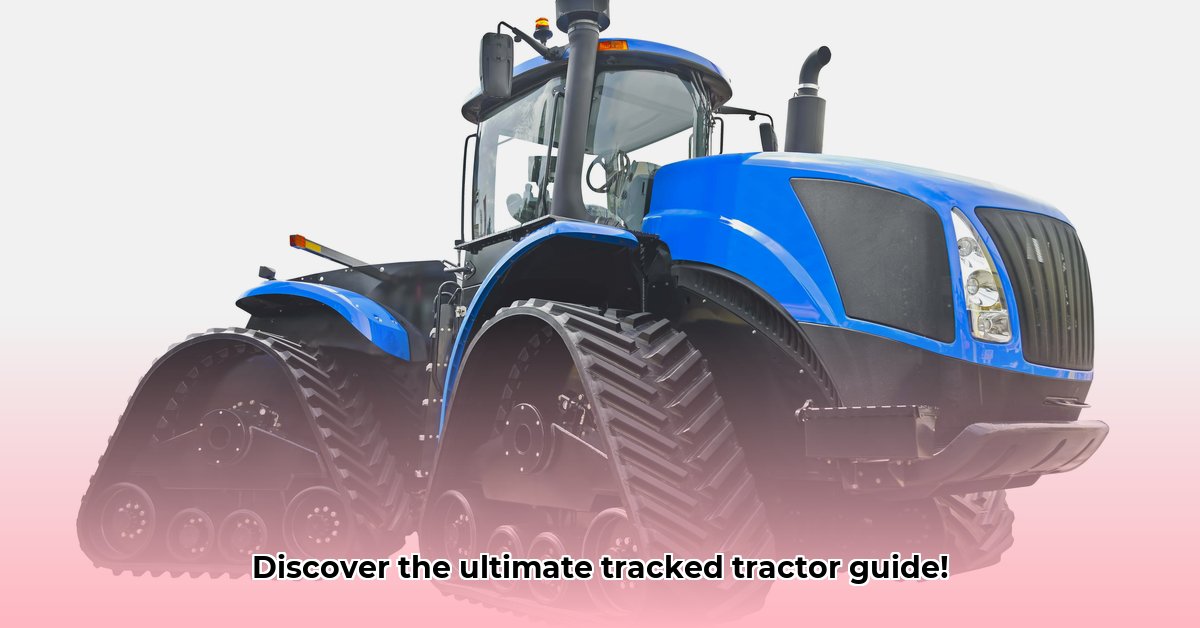
This comprehensive guide explores the world of tracked tractors, often called "tractor oruga," powerful machines designed for challenging terrains. We'll cover their capabilities, various models, and how to choose the right one for your needs.
Understanding the Power of Tracked Tractors
Tracked tractors excel where wheeled tractors struggle. Their distinctive track system offers superior traction, making them ideal for muddy fields, steep hills, and uneven ground. This superior grip minimizes wheel slippage, resulting in increased efficiency and fuel savings. This capability makes them invaluable in vineyards, orchards, forestry, and demanding construction projects.
Exploring the Diverse World of Tracked Tractor Models
Tracked tractors come in various sizes and power levels. Smaller, more agile machines are perfect for precise work in vineyards, easily navigating between rows. Larger, more robust models are ideal for construction and forestry, capable of moving heavy loads and clearing dense terrain. The best choice depends on your specific application and operational scale.
Advantages and Disadvantages: Weighing Your Options
Like any equipment, tracked tractors offer advantages and disadvantages:
| Advantage | Disadvantage |
|---|---|
| Exceptional Traction | High Initial Cost |
| Reduced Soil Compaction | Reduced Maneuverability |
| Increased Stability | Specialized Maintenance |
| Efficient in Difficult Terrain | Limited Implement Availability |
Choosing the Right Tracked Tractor: A Step-by-Step Guide
Buying a tracked tractor is a significant investment. Follow these steps for a successful purchase:
Define Your Needs: Assess your operations. What terrain will you work? What tasks are crucial? How much power do you need?
Thorough Research: Explore manufacturers and models. Consider horsepower, track width, ground clearance, and attachment compatibility.
Budgeting: Factor in the initial price, maintenance, fuel efficiency, and resale value. Create a realistic budget.
Test Drive (if possible): Experience the tractor's handling and performance firsthand. This practical experience is invaluable.
Seek Professional Advice: Consult experts for insights tailored to your specific needs.
The Future of Tracked Tractors: A Look Ahead
The agricultural machinery industry is constantly innovating. We anticipate improvements in engine efficiency, operator comfort, and integration of precision farming technology. Electric and hybrid models are emerging, promising greener and more sustainable solutions. Future advancements will likely enhance performance and minimize environmental impact.
Maintenance and Operational Best Practices
Regular maintenance is crucial for long-term reliability. This includes routine inspections, lubrication, and prompt repairs. Operator training is equally important to ensure safe and efficient operation. Proactive maintenance maximizes the return on your investment.
How to Choose the Right Tracked Tractor for Challenging Terrain
Choosing the right tracked tractor for tough terrain involves careful consideration.
Understanding Your Terrain
Analyze your land. Slopes, obstacles, soil type, and other characteristics will inform your choice. Steeper inclines need higher ground clearance and stability. Rocky terrain requires durable undercarriage components. Muddy conditions benefit from wider tracks. Don't you agree that proper terrain assessment is crucial for selecting the perfect machine?
Power and Efficiency: Finding the Right Balance
Horsepower is essential, but higher horsepower often means increased fuel consumption. Find the optimal balance. Consider fuel efficiency ratings and potential cost savings. It's a balance between power and sustainability, isn't it? A larger farm might need more horsepower, while a smaller one might choose a more fuel-efficient model.
Tracked vs. Wheeled: The Crucial Decision
Tracked tractors offer superior traction and less soil compaction than wheeled tractors. This advantage in challenging terrain is significant. However, the initial cost is typically higher. The long-term benefits of reduced soil damage and improved traction must be weighed against the higher upfront investment.
Essential Features for Challenging Terrain
- Ground Clearance: Sufficient ground clearance prevents undercarriage damage.
- Track Width: Wider tracks distribute weight, improving stability on slopes.
- Hydraulic System: A robust hydraulic system powers implements and attachments.
- Cab Comfort and Visibility: A comfortable, well-equipped cab is vital for safety and productivity.
Specialized Implements: Expanding Capability
Various specialized implements enhance versatility. Consider your farming needs and choose matching implements. The versatility of attachments is a crucial factor, isn't it?
Budget and Return on Investment (ROI)
Tracked tractors are costly. Perform a thorough ROI analysis, including fuel, maintenance, and increased productivity. Consider leasing or financing options.
Sustainability Considerations: The Future of Farming
Sustainable farming practices are increasingly important. Look for fuel-efficient engines and explore alternative fuels.
Navigating Regulations
Check for compliance with emission standards and safety regulations in your area.
Key Takeaways:
- Tracked tractors offer superior traction and reduced soil compaction, ideal for challenging terrains.
- Consider horsepower, ground clearance, track width, and specialized implements when choosing a tractor.
- Sustainable practices influence tractor selection, emphasizing fuel efficiency and reduced environmental impact.
- Thoroughly analyze costs and benefits, considering initial investment, fuel consumption, and maintenance.
- Regulatory compliance is a critical aspect of responsible tractor ownership.